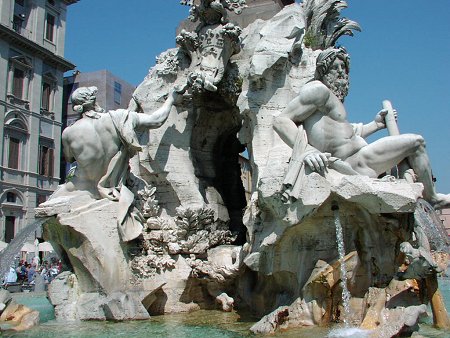|
|
 |
|
Bernini's Four Rivers Fountain |
|
written
by acz / 09.13.2004 |
|
|
| |
Function |
| |
| |

|
| www.palazzolivia.it/.../ piazza_navona_02.htm |
| The Danube and Ganges |
| Here, one can see the Danube supporting the papal crest and that, in contrast to the Ganges, the Danube is directly looking towards the symbolic light of the obelisk. |
| |
|
The overall message of the fountain is that of the power and triumph of the Church under Innocent X (particularly over paganism) and the power of the papal family. Innocent X had hoped to have the fountain completed for the Holy Year Festivities in 1650. Completed, the fountain would have been a powerful piece of propaganda with which to greet the incoming pilgrims.
Such images of triumphalism were especially important for Innocent X given the context of that period of history in the Church. In 1648, the Treaty of Westphalia was signed, bringing an end to the Thirty Years War, a series of religious and territorial battles between Protestants and Catholics. The terms of the Treaty were that the Catholic Church had to sacrifice important bishoprics in the North in order to keep Austria and Bohemia under its control. The concessions were viewed as a tragic loss to the Church. In light of such a loss, Innocent X had to somehow attempt to overcome the widespread feelings of defeatism and try to improve the image of the vitality of the Church and the papacy.
The use of an obelisk is in and of itself a powerful image of such triumphalism. Obelisks were seen as an allegory to the link between earth and heaven. Looking from bottom to top, obelisks seem to disappear, suggesting a transition from the terrestrial realm up into the heavens. Also, because obelisks were brought back from Egypt after conquests during the Imperial period, they became widely used by the Church as a symbol of the Church’s defeat of paganism. Crosses were often placed at the tops of obelisks to visually signify such a conquest. However, in the case of this obelisk the dove and olive branch take the place of the cross, a detail that further associated Innocent X, and not just the Church, with the triumph because the dove served as both a symbol of the Holy Spirit as well as the Pamphili family emblem.
Obelisks were also often viewed as a representation of the rays of the sun. With this in mind, one way of looking at the fountain is to see the different reactions of each river god to the symbol of holy light and papal government as reflective of each continent’s acceptance of the Church. The Ganges, which looks indifferently across the Piazza, and the Nile, whose head is covered, are both not looking at the obelisk which could therefore signify that those continents are each ignorant of its symbolic light. With respect to the Plata, because he shields his eyes from the light (a common gesture in antiquity used in the presence of divine light) could signify his awe of the divine power of the Church. Lastly, with respect to the representation of Europe, it is significant that the Danube was the river of choice, in the place of, for example, the Tiber located in the capital of the Church itself. Mary Christian suggests that the selection of the Danube to represent Europe and to hold up the shield of the papacy is an acknowledgement of the restoration of Austria and Bohemia to the official jurisdiction of the Church and the collapse of a Protestant stronghold achieved under the watch of Innocent X (and likely to compensate for the feelings of failure in light of losing the northern territories). Such a testament to the triumph of Innocent X would thus have provided a powerful message to the pilgrims flocking to Rome that despite the losses incurred in the Treaty of Westphalia, the vitality of the Church was still as strong as ever.
|
| |
|
| |
|
|
 |
|

